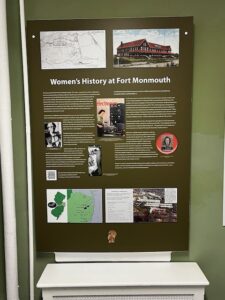Women’s History Exhibit
– By Melissa Ziobro
Since June 2022, Girl Scouts of the Jersey Shore Cadette Troop 177 has been working with the team at InfoAge to earn their Silver Award by funding a new women’s history exhibit in our Marconi Hotel headquarters.
Girls Scout cadettes can earn a Silver Award by “researching an issue, making a plan to address it, and then taking action to improve their communities.” In this case, Giuliana Demma, Mahi Shah, and Julia Calamia first decided they wanted to partner with InfoAge in some way. Upon exploration of the site’s needs, they decided they wanted to help install a women’s history exhibit, focused on the efforts of both civilian and military women at Camp Evans and its parent installation, Fort Monmouth.
Over the course of more than a year, the girls were mentored by InfoAge trustee and Monmouth University Department of History and Anthropology Specialist Professor of Public History Melissa Ziobro – learning about the work of public historians in workshops tailored just for them, sitting in on classes at Monmouth University, and conducting original research about the history of women at Camp Evans.
On July 1, 2023 these hardworking young women presented local exhibit designer Stan Cain with close to $5,000 that they fundraised, to move into the design, fabrication, and installation phase of the project. They then proofread exhibit copy and helped with the exhibit installation. A formal exhibit opening will be announced later in the Fall.
Read on for a sneak preview of the story the room tells:
Fort Monmouth hired local women to work in a civilian capacity from its very beginning during WWI. As the years went on, women found their way to the base in greater numbers and in more varied capacities. For example, the Women’s Army Corps arrived during the WWII years. The headline of the post newspaper announcing their arrival read, “Vanguard of Women’s Army Corps arrives to plan invasion of Fort.” The article began by warning men to straighten their ties and comb their hair, “press those uniforms more carefully than ever because a new impetus has been added to Army life at Fort Monmouth.”
While this is kind of playful, the Signal Corps fully appreciated the value of women in the Army. A look at the base newspaper archive shows the wide variety of roles women in uniform fulfilled on post – and how fully they were involved in life on base!
The Commanding Officer of the 15th Signal Training Regiment at Fort Monmouth, Colonel Frank H. Curtis, said of the Fort Monmouth WACs, “their pedagogical training has given them a well-diversified background…They grasp their work rapidly, and have a keen sense of loyalty. We’re glad to have them working with us.”
More than 150,000 women would serve with the Women’s Army Corps during WWII. Around 5,000 served with the Signal Corps. When WWII ended, the Army did not force women out of the service as they had following WWI. A Signal Corps board convened at Fort Monmouth in 1948 contributed to the Army’s decision to retain women in peacetime. The Board even deemed women “more adaptable and dexterous than men in the performance of certain specialties.” All the military services eventually lobbied Congress for the continued participation of women in the Armed Forces. The Women’s Armed Services Integration Act of 1948, Public Law 625, passed by the 80th Congress, consequently gave women a permanent place in the military services.
Women in uniform stayed at Fort Monmouth and its satellite installations like Camp Evans, and civilian women, who had worked on post since its WWI-era founding, increasingly entered scientific, versus clerical roles, and assumed high level leadership positions.

